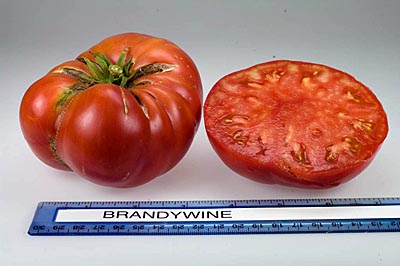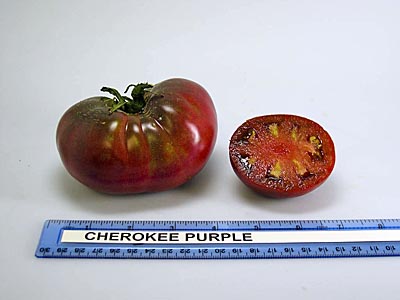Graft in the Tomato Patch
By Gil Medeiros, Fairfax Master Gardener
This is not a tale of corruption in the garden. It describes an approach you might want to consider if you like growing heirloom tomatoes, but your soil contains pathogens that frustrate your efforts.

Brandywine tomatoes

Cherokee Purple tomato
For centuries, growers have grafted the tops of woody plants such as apple trees to vigorous rootstocks. Seldom is an apple produced anywhere in the world that is not from a grafted tree. Early in the 20th century, horticulturalists in Asia began to graft watermelon plants with some success. Over the years, they learned how to graft other cucurbits and eventually solanaceous plants such eggplants, peppers and tomatoes. In Japan and Korea, this has become a mainstream farming technique, particularly for crops that are grown in greenhouses.

Cutting for grafting
Now grafted tomato plants are available to everyone — commercial farmers and backyard gardeners alike — from such vendors as Burpee, Territorial Seeds, and Johnny’s. Expect to pay a whopping $8 to $10 per grafted seedling. (That is not a misprint; they are very dear.) With a small investment in tools and a steady hand, you can make the grafted plants yourself. Johnny’s and other sources sell the tools inexpensively. Grafting instructions are widely available; but beginners should expect a high percentage of failures at the outset.
Why should you care?
If you have a small garden and cannot do the recommended five-year or three-year crop rotations (See fairfaxgardening.org vegetable gardening), you might be interested in using grafted tomatoes. Although some garden writers such as Barbara Damrosch have written skeptically about grafted tomatoes, some extension services have verified that grafted heirloom tomato plants produce significantly higher yields of tomatoes than the straight heirlooms. Noted heirloom-tomato expert and author Craig LeHoullier calls grafted tomatoes, “promising.” The grafted plants are also better at using water so they do not need to be watered as often. In other cases, depending on the rootstock, they extend the growing season because the roots are not as sensitive to extremes of heat and cold.
Are grafted tomatoes for you?
Grafted tomatoes are in no way a panacea for all tomato problems. Grafted tomato plants remedy nasty problems such as fusarium wilt, verticilium wilt, tomato mosaic virus, root-knot nematodes, and bacterial wilt. However, they are no more resistant to leaf diseases such as septoria leaf spot, early blight, or late blight than regular tomato plants. And, as noted above, they are expensive.
References
Grafting for Disease Resistance in Heirloom Tomatoes, NC State University Cooperative Extension
Epic Tomatoes, by Craig LeHoullier
In Defense of Grafting, Anne Raver, NY Times, May 29, 2013